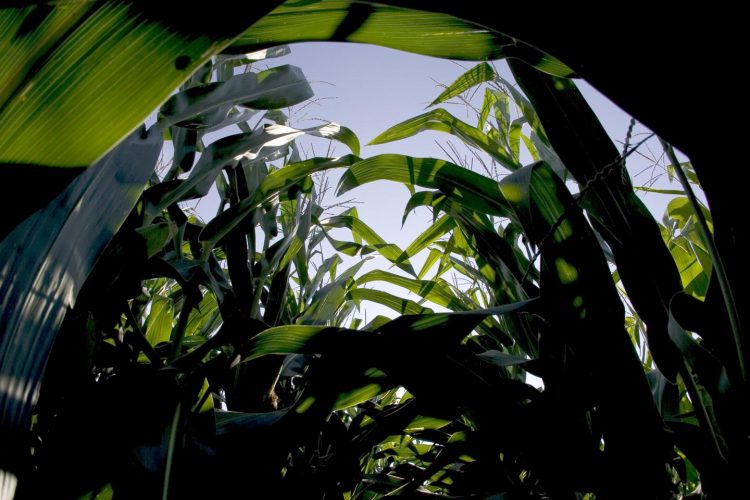Crop achilles' heel costs farmers 10 percent of potential yield

Compared to top leaves, lower leaves of C4 crops such as corn underperform, costing farmers about 10 percent of potential yield. Credit: Don Hamerman/Carl R. Woese Institute for Genomic Biology
These findings, published in the Journal of Experimental Botany, could help scientists further boost the yields of corn and Miscanthus, as well as other C4 crops that have evolved to photosynthesize more efficiently than C3 plants such as¬ wheat and rice.
“The wild ancestors of C4 crops are thought to have grown as individuals in open habitats where the number of leaves that they produced would have been limited by water and nitrogen and most leaves would be exposed to full sunlight” said principal investigator Steve Long, Gutgsell Endowed Professor of Plant Biology and Crop Sciences at the University of Illinois.
“Today we grow these crops in ever denser stands, and provide them with nitrogen and water so that they can produce many more layers of leaves. But as a result, the proportion of leaves that are shaded has increased, and the production of grain will depend more and more on the contribution of this increasing proportion of shaded leaves. So how do the Maseratis of photosynthesis, C4 crops, do when they are on a meager meager fuel ration in the shade?”
Not well, according to this paper: when top and bottom leaves are placed in the same low light, the lower canopy leaves showed lower rates of photosynthesis. Shaded corn leaves are 15 percent less efficient than top leaves–and worse, lower leaves are 30 percent less efficient than the top leaves of Miscanthus, a perennial bioenergy crop that is 60 percent more productive than corn in Illinois.
Considering the crop as a whole, this loss of efficiency in lower leaves may costs farmers about 10 percent of potential yield–a cost that will increase as planting density increases. This 'Achilles' heel' likely applies to other C4 relatives, such as sugarcane and sorghum.
“What's interesting is that we saw this loss in efficiency in the lower canopy was not due to the leaf senescing and dying off–we would have expected that,” said first author Charles Pignon, a doctoral candidate in the crop sciences and at the Carl R. Woese Institute for Genomic Biology. “The leaves were still perfectly healthy when we were looking at them; they were even darker. In the article, we show through experiments that this was not caused by age.”
“Next, it will be important to find out why this loss in efficiency occurs and if there's any way that we can fix it, since overcoming this and gaining a 10 percent increase in production would be very significant,” Pignon said.
###
The paper “Loss of photosynthetic efficiency in the shade. An Achilles heel for the dense modern stands of our most productive C4 crops” was published in Journal of Experimental Botany . Co-authors also include Deepak Jaiswal and Justin McGrath, a postdoctoral researcher at the University of Illinois.
This work was supported by the Energy Biosciences Institute (EBI). The EBI is a public-private collaboration supported from BP in which bioscience and biological techniques are applied to help solve the global energy challenge. For more information, visit http://www.
Media Contact
All latest news from the category: Agricultural and Forestry Science
Newest articles

Silicon Carbide Innovation Alliance to drive industrial-scale semiconductor work
Known for its ability to withstand extreme environments and high voltages, silicon carbide (SiC) is a semiconducting material made up of silicon and carbon atoms arranged into crystals that is…

New SPECT/CT technique shows impressive biomarker identification
…offers increased access for prostate cancer patients. A novel SPECT/CT acquisition method can accurately detect radiopharmaceutical biodistribution in a convenient manner for prostate cancer patients, opening the door for more…

How 3D printers can give robots a soft touch
Soft skin coverings and touch sensors have emerged as a promising feature for robots that are both safer and more intuitive for human interaction, but they are expensive and difficult…





















